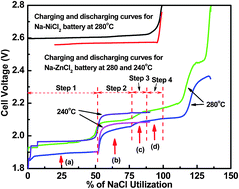A novel low-cost sodium–zinc chloride battery†
Abstract
The sodium–metal

* Corresponding authors
a
Energy and Environment Directorate, Pacific Northwest National Laboratory, Richland, WA 99354, USA
E-mail:
Jin.Kim@pnnl.gov
Fax: +1 509 375 2186
Tel: +1 509 375 2225
The sodium–metal

 Please wait while we load your content...
Something went wrong. Try again?
Please wait while we load your content...
Something went wrong. Try again?
X. Lu, G. Li, J. Y. Kim, J. P. Lemmon, V. L. Sprenkle and Z. Yang, Energy Environ. Sci., 2013, 6, 1837 DOI: 10.1039/C3EE24244G
To request permission to reproduce material from this article, please go to the Copyright Clearance Center request page.
If you are an author contributing to an RSC publication, you do not need to request permission provided correct acknowledgement is given.
If you are the author of this article, you do not need to request permission to reproduce figures and diagrams provided correct acknowledgement is given. If you want to reproduce the whole article in a third-party publication (excluding your thesis/dissertation for which permission is not required) please go to the Copyright Clearance Center request page.
Read more about how to correctly acknowledge RSC content.
 Fetching data from CrossRef.
Fetching data from CrossRef.
This may take some time to load.
Loading related content
